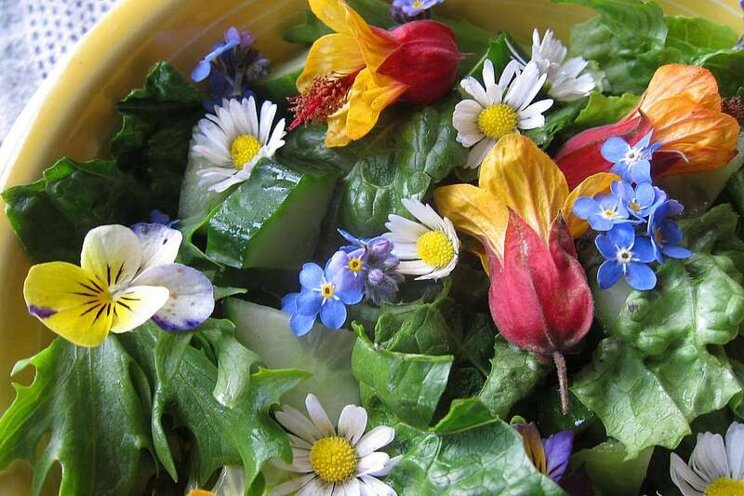Edible flowers for garden and dinner table
Added on 12 February 2020

Can I eat that flower?
Back in the middle of the last century, homemaker Jean Kerr wrote a memoir about raising her children titled "Please Don't Eat the Daisies." Most Americans just chuckled at the title (and a Doris Day movie made from the book), having never considered eating a daisy or any other garden flower. But the most adventurous cooks and gardeners wanted, even then, to know which daisies she meant, and exactly why her children shouldn't eat them. They might even have known that English daisy flowers (Bellis perennis) are edible, and wondered about eating other daisies, such as the large Shasta daisies.
Since that book was a hot cultural item, the idea of adding joyful color and often surprising flavor to our meals by including flowers has become more mainstream. But still, many garden plants bear edible flowers that are rarely eaten.
People who eat flowers mainly choose from a short list that includes nasturtium, borage, viola and calendula. Some gardeners know that the flowers of most vegetables and herbs are also edible (except those of tomato, potato, pepper or eggplant which contain toxins). But daisies are still mostly unexplored territory, as are many other edible flowers of ornamental plants.
Ten to try
Here are 10 commonly grown in the Bay Area:
English and other daisies: You can indeed eat English daisies, the kind that grow in lawns as well as the larger domestic varieties of English daisy that bloom in white, pink or red.
Shasta and oxeye daisies (Leucanthemum x superbum and Leucanthemum vulgare) are also edible, but should be used in moderation because of their strong, distinctive flavor. Tear off and use their petals (ray flowers). She loves me, she loves me not ...
Japanese edible chrysanthemum: Data is scanty on other species that are also commonly called daisies, but one with daisylike flowers is definitely edible: Japanese edible chrysanthemum, a.k.a., shungiku or tong ho. The young leaves are a part of several Asian cuisines. Use the pale or bright yellow petals.
Forget-Me-Not (Myosotis): This winter- and spring-blooming annual with small blue flowers comes back from year to year. Blooms can be sprinkled on a salad or pressed onto the surface of a soft cheese — maybe with some violas and pink or red English daisy petals.

'Opening Night' tea rose is fragrant, disease resistant and heat tolerant.
Photo: Pam Peirce
Rose: All rose petals are edible; the better the scent, the better the flavor, but remove the white lower tips (called the heels), which are often bitter. Rose petals are good in green or fruit salads, or you can candy them or make rose syrup or jelly. Avoid florist's roses, which tend to lack scent and flavor and may have been sprayed with a toxic pesticide.
Dianthus & carnation: The petals are edible, often with a clovelike, sweet flavor. As with roses, however, cut off the white heels, as they are likely to be bitter. Decorate a salad, or float on soup or punch. Always avoid florist's flowers.
Daylily: We're talking hemerocallis here, like the yellow 'Stella d'Oro,' not true lilies (Lilium). Daylily petals are fine in salads, soups or stir-fries. Or you can saute whole buds or flowers lightly and then stuff them with various fillings. The flavor is sweet and delicate. Dried hemerocallis buds are the "golden needles" of Chinese cuisine, which are soaked in warm water for 90 minutes to reconstitute, then used in soup or a stir-fry.
Scented geraniums (Pelargonium): These semi-woody, often sprawling plants are hardy in our region's landscapes. The flavors of different varieties range from peppermint to rose. Use the petals in a fruit salad or put whole flowers at the bottom of a cake pan so that the cake, after baking, can be inverted to reveal a scented, flowery top.
Fuchsia: All kinds of fuchsia flowers are edible, and mighty decorative, too. It's best to remove stamens and pistils before you eat the flowers; if you are choosing a variety to plant, make sure it is fuchsia-mite resistant. The fuchsia berry is edible too, but bland in flavor.

Gardeners treasure camellias for the bright blooms and shiny leaves they add to shady locations. This one is Camellia japonica 'Mathotiana'.
Photo: Pam Peirce
Camellia sasanqua, japonica and hybrids: Petals of these close relatives of the tea plant are edible. They make an attractive garnish, or can be dried and added to tea, though you will want to use healthy, disease-free petals. (If your camellia has petal blight, as many in the Bay Area do, it will have browning and falling flowers. Fight this by removing all the browning flowers from the plant and the ground. Repeat as long as browning petals appear. Remove any old mulch and lay down a fresh wood chip mulch to block fungus spores from splashing back up into the plant.)
Abutilon (Flowering Maple): The flowers of all species are edible, but the ones of the red-and-yellow-flowered Abutilon megapotamicum are the most commonly eaten. They may be eaten raw or used as a vegetable.
Source and Photo Courtesy of San Francisco Chronicle
Source: San Francisco Chronicle
More news















